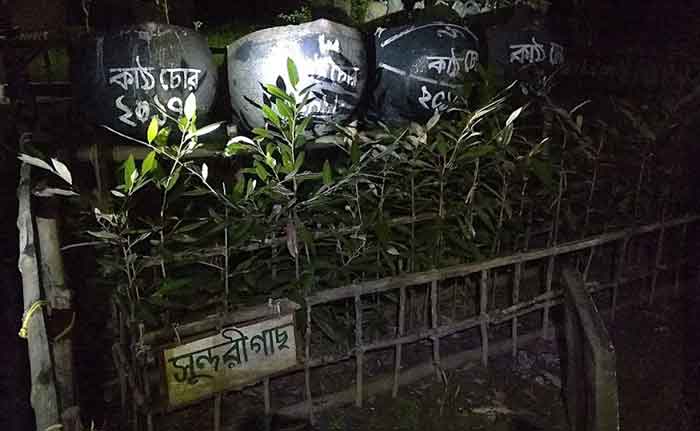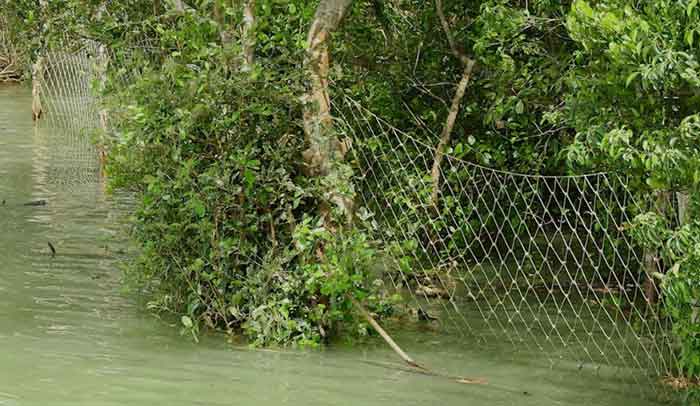Share:
The story of the Sundari is as fascinating as its namesake—the Sundarbans, the world’s largest contiguous mangrove forest, situated across coastal Bangladesh and the state of West Bengal in India where it is also a UNESCO world heritage site, a designated national park, a tiger reserve, and a biosphere reserve.
Sundari is as elusive as the most celebrated resident of the Sundarbans—the Bengal tiger. One might spend days on boats, the only way to tour through this forest, mostly during the months of October to May before the arrival of heavy monsoon showers—yet spot none of the two iconic species. Ironically, both tiger and Sundari have been assessed as endangered by the International Union for Conservation of Nature (IUCN) Red List of threatened species. Yet, one species is totally under global spotlight with millions spent on its protection and conservation, while the other dies a silent death, unknown and unsung. You might have guessed by now which is which—the Bengal tiger is the former and the Sundari, unfortunately, is the one that struggles to hold its ground.
Sundari means “the beautiful” in Bangla, the language spoken in West Bengal and Bangladesh. And very few would recall today that the mangrove forest is named after the once abundant Sundari tree.

Sundari Tree with trunk and above-ground roots. Photo by Bishnu Sarangi / Pixabay.
The Sundari, which used to be the dominant mangrove tree species of the Sundarbans, is scientifically known as Heritiera fomes, and with various common names including sunder, sundari, jekanazo and pinlekanazo. The Sundari tree can grow up to 60 feet in height with a girth of 6 feet. The tall hardy tree with elliptic shaped leaves and micro-nutrient rich fruit is facing many threats: over harvesting, water diversions in the Ganges Basin, fluctuations in salinity due to upstream and coastal development, and a top-dying disease.
A major timbre-producing tree, Sundari also has applications in traditional folk medicine as evidenced by its extensive use for treating diabetes, hepatic disorders, gastrointestinal disorders, goiter, and skin diseases by the local people and traditional health practitioners. A number of investigations indicated that the Sundari tree possesses significant antioxidant, antinociceptive, antihyperglycemic, antimicrobial, and anticancer activities.
The species is now on the brink of extinction in Indian Sundarbans due to overcutting and increased salinity.
“It is very difficult to find a Sundari tree in the Sundarbans as the species has a lower tolerance for saline seawater and there isn’t much high ground left, especially on the Indian part of the Sundarbans. Global warming has not just increased surface temperatures but also the saline content in the seawater,” Santhosha Gubbi, a Divisional Forest Officer of the Sundarban Biosphere Reserve told me last August when I visited the forest.
A study by the Indian Institutes of Technology points out that unlike other mangrove species Sundari prefers extremely low saline condition and hence can act as biological indicator of climate change related to sea level rise. The tree can flourish luxuriantly under low salinity conditions. Physiological studies have revealed that mangroves are not salt lovers, rather salt-tolerant. Excessive saline conditions can retard seed germination, impede growth and development of mangroves. When the salinity increases, the species becomes stunted, rare and ultimately disappears. The research shows the adverse impact of salinity on leaf chlorophyll, an indispensable raw material for running the photosynthesis process. Various studies have shown that a number of mangrove species grow best at salinities between 4 and 15 psu (Practical Salinity Unit). For Sundari, the preferred salinity range is lower. At increased salinity, like 20 psu, the seedlings could hardly adapt.
Sundari is also known for its flexibility and longevity, one of the main reasons people prefer Sundari as timber over the other mangrove wood. For this reason, Sundari is in trouble in Bangladesh also.
“Before 1985, Sundari logs were sold openly, but in that year, in response to declining numbers the species was protected, with the felling, sale and transportation of Sundari logs banned,” journalists Habibur Rahman and Andrew Eagle reported in Bangladesh’s Daily Star four years ago. However, the ban didn’t stop the peril of Sundari. The article featured the largest floating timber market in Bangladesh, Pirojpur’s Nesarabad upazila, and exposed that large-scale illegal trade of the rare Sundari continues unabated highlighting the dark side of the timber industry. “It’s now 31 years later and their sale is yet to cease,” Rahman and Eagle wrote. Sundari logs are often carried by trawler to avoid detection. “At the time of unloading each log is measured such that when customers arrive they are provided written measurements only, prior to purchase, with purchased logs reloaded onto boats, for onward transport, in the dead of night.”

Confiscated Sundari timber with boats in the background and young Sundari trees in the foreground, Sundarbans Biosphere Reserve. Photo by Ananda Banerjee, August 2019.
Satellite data analysed by Earth.org paints a dismal picture. The Sundarbans is slowly shrinking due to human encroachment and climate change. “The forest has been losing almost 16 sq km of vegetation per year since 1991,” Earth.org informs.
A fortnight ago both the jungle and the city of Kolkata was in the eye of the biggest cyclone in recorded history—Amphan (pronounced as “Um-p un”, meaning the sky). The huge storm surge estimated around five metres (16.5 feet) inundated all low-lying areas leaving a trail of catastrophic damages. Sundarbans, a spread of 10,000 sq km, is no stranger to cyclonic storms but the frequency and intensity has gone up in recent years. In six months, the mangrove jungle has been struck twice—by cyclone Bulbul in November last year and Amphan in May this year. Amphan has undoubtedly left behind a deluge of humanitarian crisis (along with the lockdown to curb the COVID-19 pandemic) but what it has done to the natural ecosystem of Sundarbans is far more irreparable.

Red fiddler crab, Sundarbans Biosphere Reserve. Photo by Ananda Banerjee, August 2019.

Common sandpiper, Sundarbans Biosphere Reserve. Photo by Ananda Banerjee, August 2019.
“The super cyclone might have killed and displaced a large number of species which inhabit the delta. From fish to reptiles to mammalian inhabitants, a huge number is likely to have perished in the cyclone, however we are not certain of the damage. But I fear the loss of prey, especially wild boar and deer population, might result in a diminishing prey base for the tiger, which in turn can aggravate human-tiger conflict in the region,” Pradeep Vyas, former director of Sundarbans National Park told me over the phone.
Experts are of the opinion that the loss of human lives and livelihood could have been even more severe if not for the Sundarbans. This unique coastal ecosystem shock absorbs the initial impact of the storm and is said to reduce wind speed by 20-25 kms per hour before it makes inroads towards human settlements along the forest fringes. Mangroves are natural ecological barriers, resilient to extreme weather events like cyclones, protecting coastal communities from frequent storm surges and reduce long-term deterioration of the inter-tidal zone. However, the long-term effects of climate change could erase this natural protection scheme. Globally, the mangroves also account for 14 percent of coastal carbon sequestration.

Vast stretches of mangrove forest in the Sundarbans Biosphere Reserve. Photo by Ananda Banerjee, August 2019.
Among the various reports coming in the aftermath of Amphan is that the vegetation in the peripheral forest has turned yellow due to the excessive saline water dumped by the cyclone.
The current nature of water in the numerous river channels in Sundarbans is direct fallout of one of the several environmental impacts of dams on rivers—the slow continuous diminishing flow of fresh water downstream. In 1975, the controversial Farakka Barrage (dam) came up on the Ganga, the “holy river” of India, few miles before the river meanders into Bangladesh. Over the years as the freshwater flow reduced because of diversion for agricultural and other developmental needs—the sea filled in the void, especially in the delta, where the Sundarbans is situated.
Speaking from twenty years of field experience in Sundarbans, Vyas says, “The entire central and western part of the Indian Sundarbans is now a backwater of the sea. The wide Matla River that we all sail to get into the tiger reserve is brackish except for the monsoon months. To my estimate there has been a staggering 95% decline in Sundari trees in the Indian part of the Sundarbans. The few trees, which are still standing, are along the international border with Bangladesh but they are not anywhere close to what a grand Sundari looks like as found on the eastern part of Bangladesh Sundarbans.”
In the Indian part of the jungle, species such as Dhundul (Xylocarpus granatum), Passur (Xylocarpus moluccensis), Kakra (Bruguiera gymnorhiza), Genwa (Excoecaria agallocha), Goran (Ceriops decandra) and Garjan (Rhizophora apiculata)—have proliferated and taken over the space left by the Sundari.

Mangrove trees of Sundarbans, Netidhopani Camp, Sundarbans Tiger Reserve. Photo by Subhankar Banerjee, August 2019.

Garjan tree with above-ground roots, Sundarbans Biosphere Reserve. Photo by Ananda Banerjee, August 2019.
This shift in species composition is also highlighted in Swapan Kumar Sarker’s research. Over the past three decades, Sarker has witnessed the local extinction or range contraction of many endemics including the Sundari in the Bangladesh Sundarbans. “I found historical tree harvesting, siltation, disease and soil alkalinity as the key stressors that negatively influenced the diversity and distinctness of the mangrove communities in the Sundarbans.” Sarkar’s work reveals that the Sundari is not safe in Bangladesh Sundarbans either where ‘top-dying disease’ is wreaking havoc. The affected trees go bald on the top and the stems show signs of swelling and formation of several knots known as “heart-rot.” In the last thirty years, the top-dying disease has killed 15 per cent of Sundari trees in the Bangladesh Sundarbans,” the Dhaka Tribune reported two years ago.
According to experts the rising temperatures and increase in salinity have also brought microbial-fungal diseases and insect pests. Researcher Katie Louise Awty-Carroll and team from the Department of Geography and Earth Sciences, Aberystwyth University, UK, demonstrated through analysis of remote sensing data that there is a 25 per cent negative trend in mangrove cover due to the effect of die-back of Heritiera fomes, or the Sundari. These areas are now at greater risk of decline in the future, especially if extreme events such as cyclones become more common.
Last August, I visited the Sundarbans Biosphere Reserve in West Bengal. Negotiating one of the several small creeks in the mangrove, somewhere close to Bonnie camp (21°49’50″N, 88°37’24″E), forest guard Amin Chand Mondal narrated (see video below) his experiences going back to the 1980s when logging permissions used to be granted in different forest blocks for the Sundari. Mondal said that most of the grand old Sundari trees fell to the axe, and the ones that survived the human greed faced an existential crisis. “There was a time when the Sundari tree was abundant in the mangrove forest, but today spotting it is like looking for a needle in a haystack.”
If we consider the peril of Sundari within the larger biological crisis, we realize that, each year, between 18,000 and 55,000 species are becoming extinct; the daily maximum is about 150 species.
Paul Elrich, a wildlife biologist from Stanford University and Gerardo Ceballos, an ecologist at the National Autonomous University of Mexico, with other colleagues recently revisited their 2015 study, “Accelerated modern human–induced species losses: Entering the sixth mass extinction,” which made global news headlines at the time. The revised study, published on June 1, estimates that the rate of species extinction is likely much higher than previously thought. Species are disappearing even faster than science can study and decipher them.
The tragic peril of species all over the world is an alarm call and the reason why this year the United Nations is putting the spotlight back on biodiversity with the theme ‘Celebrate Biodiversity’ on June 5, a day marked as World Environment Day to promote global awareness and action for the environment.

Net fencing to prevent the tiger from leaving the protected areas and coming into human habitation, Sundarbans Biosphere Reserve. Photo by Ananda Banerjee, August 2019
There are many like Amin Chand Mondal in the West Bengal Forest Department who valiantly guard the almost-impenetrable Sundarbans mangrove, night and day, under difficult circumstances, beating inclement weather and the omnipresent threat of attack from wild animals, especially the tiger. They know every little creek and island (which looks the same to an outsider) in this dense forest and have superb eye for spotting species and poachers. They are invariably at a loss, especially the older generation, when a tourist or naturalist inquires after the elusive Sundari. Some of the younger guards have never seen the Sundari except for the small plantations undertaken by the forest department in their outposts. For several years, visitors including scientific experts, have come back from the forest dejected without having spotted the beautiful tree. It is no irony that the visual signage promoting and depicting the Sundarbans today—posters, brochures and other paraphernalia—does not even mention the Sundari tree. Instead what we see is Garjan with its extensive above-ground roots as the dominant species.
“There was a time when lots of Sundari tree could be seen in the forest. But in the early 1980s, permission was given to cut down a certain number of trees in each block of Sundarbans area. This exercise was carried out in each block in the presence of the range officer and beat officer; almost 500 to 1000 quintal of timbre would be loaded in boats. This is when several mangrove species, included the Sundari, were destroyed. Although there is a ban on felling of tress today, most ancient trees that formed the Sundarbans ecosystem—area no longer to be seen. There are very few Sundari trees today, especially owing to the saline content of the water. The Sundari tree does not grow in low lying areas, it needs the top-most soil where the high tide does not inundate.”
–from the narration (translated from Bengali to English) by Amin Chand Mondal.
Mangrove nursery, Sundarbans Biosphere Reserve. Photo by Ananda Banerjee, August 2019.

Tiger pugmarks and mangrove sapling, Sundarbans Biosphere Reserve. Photo by Ananda Banerjee, August 2019.
After highlighting the peril of Sundari, Mondal offered the possibility of a hopeful future for the species that does require courage and concerted efforts: “It is still possible to revive the growth of Sundari trees in the forest, although it will be a difficult job for us forest guards in a tiger terrain. Saplings can be grown in nursery and transplanted in the forest. Sundarbans can once again have the Sundari tree back.”
Ananda Banerjee is an award-winning journalist, author and graphic artist. He is Editor of Special Projects at the Outlook Group, one of India’s leading media houses, and Consulting Editor at GoNewsIndia, the country’s first app-based news channel. Ananda co-founded Paryavidhi, an Environmental Law Quarterly magazine published by Environment Law and Development Foundation. He is also a consultant for Deutsche Forest Service (DFS) / Deutsche Gesellschaft für Internationale Zusammenarbeit GmbH (GIZ-India) which focuses on Human-Wildlife Conflict Mitigation in India as part of an Indo-German Biodiversity Programme. Editor of Nature Chronicles of India, Essays on Wildlife (Rupa & Co, 2014) and author of Common Birds of the Indian Subcontinent (Rupa & Co, 2008), Ananda is currently cowriting (with Subhankar Banerjee, with drawings by laura c carlson) a book on biological annihilation to be published by Seven Stories Press.
Originally published in Species In Peril
SIGN UP FOR COUNTERCURRENTS DAILY NEWS LETTER













































